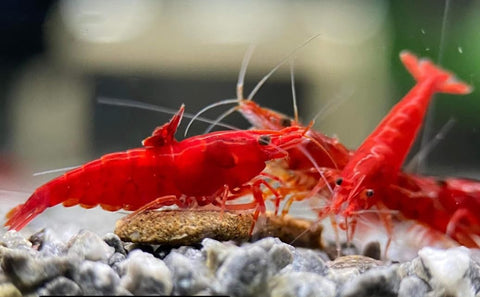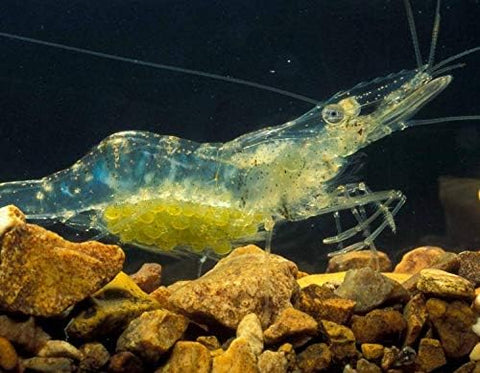While aquaponics has primarily been associated with fish and various leafy greens, raising shrimp in aquaponics systems is a lesser-known but equally fascinating facet of aquaponics. You read that right; you can cultivate shrimp alongside your greens and fish in your aquaponics system.
In this guide, we'll explore the intricacies, benefits, challenges, and rewards of integrating shrimp into your aquaponics setup. Whether you're a seasoned aquaponics enthusiast looking to expand your system or a beginner wanting to explore sustainable seafood options, this blog will provide valuable insights and practical knowledge on raising shrimp in aquaponics.
Overview of Raising Shrimp in Aquaponics
While fish and leafy greens like lettuce and herbs have been the primary crops in aquaponic systems, shrimp farming has emerged as a tantalizing possibility. These tiny crustaceans can thrive in the same environment as fish and plants, contributing to the nutrient exchange and adding diversity to your aquaponic setup. Including shrimp in your system introduces the prospect of enjoying a sustainable source of protein alongside your vegetables.
Why Shrimps are Gaining Popularity in Aquaponics
Shrimp are increasingly recognized as a sustainable alternative to traditional aquaponic fish species like tilapia or catfish. Their rising popularity is driven by several key advantages:
- Eco-friendly and low-maintenance: Shrimp require minimal space and fewer resources to thrive, making them perfect for small-scale aquaponic farms or even indoor systems.
- Natural biofilters: Shrimp acts as scanvengers and help break down waste and prevent buildup of uneaten food and organic debris. This supports better water quality and reduces system maintenance.
- Increased yield diversity:Beyond vegetables and leafy greens, shrimp provide an additional crop for consumption or sale, an attractive bonus for those seeking self-sufficiency or local market opportunities.
-
Perfect for home-growers:If you're running a backyard aquaponics system, shrimp offer a low-risk way to scale up your output without needing additional tanks, equipment, or major redesigns. Their peaceful nature, combined with easy integration into existing ecosystems, makes them a practical choice for, indoor systems, balcony or patio gardens, community gardens and school or educational projects.
The Benefits of Integrating Shrimp in Aquaponics
- Diversity: Including shrimp diversifies your aquaponic ecosystem, which can improve system resilience and balance.
- Nutrient source:Shrimp waste serves as an additional source of nutrients for plants, reducing the need for external fertilizers.
- Ecosystem health: Shrimp contributes to the overall health of the system by participating in the nutrient cycle and promoting biological diversity.
- Protein production:Harvesting shrimp from your aquaponic system can provide a sustainable source of protein.
Types of Shrimp Commonly Raised in Aquaponics
Aquaponics systems can host several freshwater shrimp varieties, depending on your preferences and system design. Freshwater shrimp, like the Red Cherry Shrimp, are known for their ease of maintenance and adaptability to various water conditions.
Popular Shrimp Species for Aquaponics:
1. Red Cherry Shrimp: These freshwater shrimp are known for their vibrant red coloration and are often chosen for their ornamental value and role in nutrient cycling.
Pros:
- Peaceful, easy to breed
- Great for small/nano systems
- Excellent natural scavengers
- Thrive in a wide range of pH and temperatures
Cons:
- Too small to harvest for consumption
- Sensitive to copper and chemical spikes
-
Vulnerable to predation from fish

2. Ghost Shrimp: Freshwater ghost shrimp are transparent and make excellent scavengers in aquaponic systems, helping to clean up debris and residue.
Pros:
- Very inexpensive and easy to source
- Help keep the substrate clean
- Tolerates a broad range of temperatures
- Fast breeders in the right conditions
Cons:
- Shorter lifespan (1–2 years)
-
Prone to stress in unstable systems

3. Freshwater Shrimp: Often considered the gold standard in freshwater prawn, is a large, fast-growing shrimp native to tropical regions. It’s popular among aquaponics farmers looking for a meaty harvest with high market value.
Pros:
-
High yield potential
-
Rapid growth (harvest size in ~5–6 months)
-
Tolerant of a wide range of water conditions
-
Excellent for polyculture with tilapia
Cons:
-
Can be aggressive, especially males
-
Requires warm temperatures (ideally 78–88°F)
-
Needs space due to territorial behavior

Compatibility With Other Aquaponics Components
1. Fish species selection: When integrating shrimp into your aquaponics system, it's important to choose fish species that are compatible with shrimp. Avoid predatory fish that might view shrimp as a tasty snack. Opt for peaceful fish varieties like tilapia or catfish, which typically coexist harmoniously with shrimp. Additionally, consider the water temperature requirements of both the fish and shrimp to ensure they are compatible.
2.Plant selection and growth requirements: The choice of plants in your aquaponics system should also align with shrimp farming. Leafy greens, herbs, and some fruiting plants work well. Ensure that the plant's growth requirements, such as light, pH, and nutrient preferences, match the conditions in your system. Plants should be capable of utilizing the nutrients produced by the shrimp and other aquatic life in the system effectively.
Setting Up Your Shrimp Aquaponics System
Creating a successful shrimp aquaponics system requires careful planning and attention to various design considerations. Below, we will explore the critical factors involved in setting up your shrimp aquaponics system.
A. Design Considerations
1.Tank size and layout:
- Tank size:Shrimp tanks should be appropriately sized to accommodate the stocking density, and the expected growth of your shrimp. Consider factors such as the number of shrimp, their species, and the available space.
- Tank layout:Design your shrimp tanks with compartments to provide hiding places and ensure efficient water flow. Shrimp like to hide, so incorporating structures like PVC pipes, rocks, or plants can create a comfortable environment.
2.Water filtration and circulation:
- Filtration:High-quality filtration is crucial to remove waste and maintain water clarity. Mechanical and biological filtration systems, such as filters, can keep water clean.
- Circulation: Adequate water circulation helps distribute oxygen and nutrients evenly. Use air pumps, water pumps, or air stones to ensure water moves consistently throughout the tank.
3.Temperature and environmental control:
- Temperature control:Maintain the water temperature for your shrimp and fish species. Heaters and chillers may be necessary, mainly if you are farming shrimp with specific temperature requirements.
- Lighting:Consider the lighting needs of any plants in your aquaponics system. Shrimp may not require specific lighting, but your plants certainly will.
B. Stocking density and ratios
- Determine the ideal stocking density based on your tanks' size and your shrimp's expected growth rate. Overcrowding can lead to stress, disease, and poor water quality.
- Balance the number of shrimp with the capacity of your aquaponic system to process their waste. Ensure that the beneficial bacteria can effectively convert ammonia to nitrates for plant uptake.
- Avoid overstocking, as it can lead to poor water quality and slower growth rates for shrimp and fish.
C. Water quality management
1. pH levels and buffering:
- Measure and maintain the pH levels within the preferred range for your shrimp species. Many shrimp species thrive in slightly alkaline water, typically with a pH between 7.0 and 8.0.
- Buffering agents, such as crushed coral or limestone, stabilize pH levels and prevent rapid fluctuations.
2.Monitoring ammonia and nitrate levels:
- Regularly test water parameters to ensure that ammonia and nitrate levels are within safe ranges for shrimp. Ammonia should be nearly undetectable, and nitrate levels should be suitable for plant growth.
- Implement water changes as needed to reduce nitrate levels and maintain water quality.
Feeding and Nutrition for Shrimp
Properly addressing the dietary requirements of your shrimp ensures their growth and overall health while contributing to the success of your aquaponic system.
1.Dietary requirements of shrimp
- Shrimp are carnivorous creatures with a high demand for protein. Their diets should consist primarily of protein sources to support their growth and development.
- Shrimp require a balanced diet that includes protein and essential nutrients like vitamins and minerals. These nutrients contribute to their overall health and immune function.
- Key nutrients include vitamins C and E, calcium, phosphorus, and iodine.
2.Choosing the appropriate shrimp feed (pellets vs. natural food sources):
- Pellets:Commercial shrimp pellets are a convenient and widely used option. They provide a controlled and balanced diet that meets the nutritional needs of shrimp. Pellets are especially useful in aquaponics, as they are easy to dispense and monitor.
- Natural food sources:You can incorporate live or frozen foods such as brine shrimp, daphnia, or bloodworms.
3. Feeding frequency and portion control
- Overfeeding can lead to water quality issues, as uneaten food can break down and produce ammonia, which is harmful to shrimp and other aquatic life.
- Feed your shrimp small portions of feed several times a day rather than a large amount all at once. This helps ensure they consume the food and reduces waste.
- Monitor your shrimp feeding behavior and adjust the amount of food accordingly. If food accumulates on the tank bottom, reduce the feeding portion size.
Monitoring Shrimp Health
1.Common diseases and issues:
- Shrimp can be susceptible to various diseases and health issues, including bacterial infections, fungal infections, and parasites. Common indicators of health problems include changes in behavior, discoloration, or unusual swimming patterns.
- Water quality plays a significant role in shrimp health. Poor water conditions can stress shrimp and make them more susceptible to diseases.
2.Preventative measures and treatments:
- Maintain high water quality by regularly testing parameters like pH, ammonia, nitrate, and temperature. Keep these conditions within the optimal range for your shrimp species.
- Quarantine new shrimp before introducing them to your main tank to prevent the spread of diseases.
- Implement good hygiene practices, such as cleaning tank components and avoiding overfeeding.
- In case of disease outbreaks, consult with aquaculture experts or veterinarians for appropriate treatments and medications.
3.Harvesting shrimp
- Shrimp are ready for harvest when they reach a size suitable for consumption. The exact size varies depending on the species and your preference, but they are usually harvested when they are several inches long.
- To harvest shrimp, you can use a fine mesh net or trap them in a container with a hole small enough to prevent them from escaping while allowing water to flow through. Alternatively, you can partially drain the tank for easier access.
Additional Information on Raising Shrimp in Aquaponics
- Shrimps take 4 months to reach market size.
- Shrimps thrive on the temperature of 75 to 85 degrees the most (tilapia requires 75 to 90° which makes them perfect pairs)
- You can harvest shrimps 3 times a year because their growth cycle is 4 months.
- The pH of the water should be between 7.8 and 8.5.
- Aeration or airflow is essential in raising shrimps. So, it would help to have an air pump or a flow of water mixed with air to aerate the water for your shrimp.
Conclusion
Integrating shrimp into your aquaponics system is a flavorful and environmentally conscious choice. Choosing the suitable shrimp species and maintaining a harmonious balance between fish and plants will help you create an ecosystem where every component thrives.
As you embark on your shrimp aquaponics journey or simply appreciate the potential of this remarkable farming practice, remember that every tank, every shrimp, and every harvest is a testament to the harmony of nature and human ingenuity. In aquaponics, the possibilities are as vast as the ocean, and with each growth cycle, you're contributing to a greener, more sustainable future. So, dive in, cultivate your aquatic garden, and savor the flavors of success in every shrimp you raise.






Ephraim S Motsepe
January 25, 2025
What a well articulated information regarding the acquaponics more especially in shrimps and tilapia and plants of which I’m really determined to venture into thanks a lot 🙏